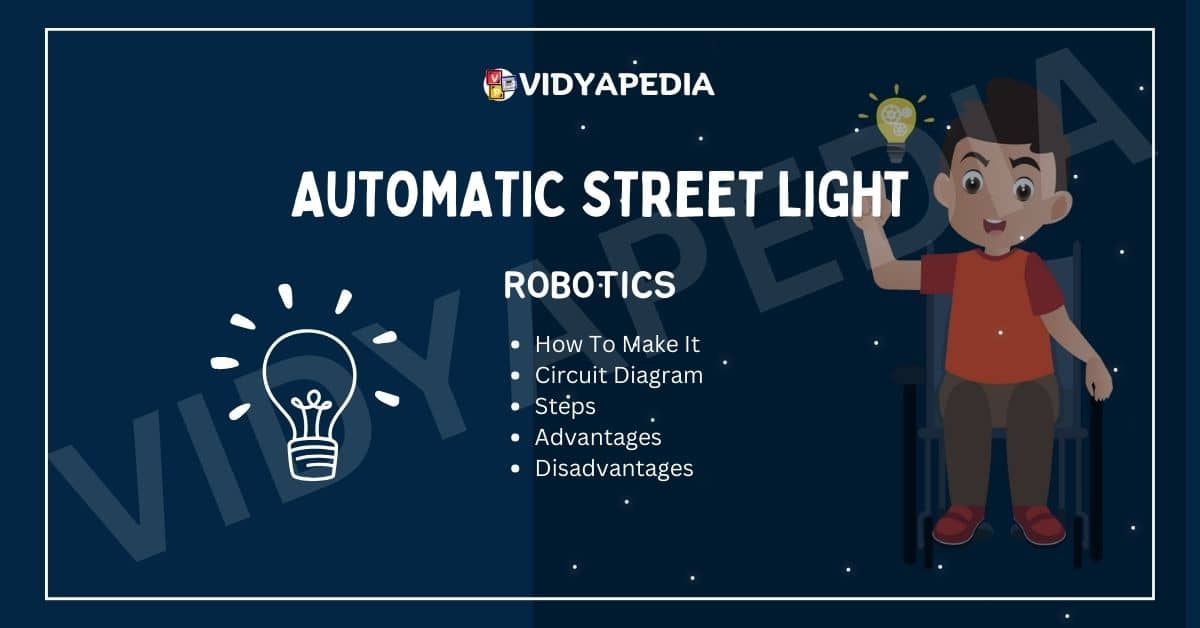Introduction
Automatic street light and dark detector circuits are groundbreaking approaches to urban lighting efficiency. These systems use advanced technology, such as light sensors and clever control circuits, to automatically modulate street light operation based on ambient lighting conditions.
What is an Automatic Street Light/Dark Detector Circuit?
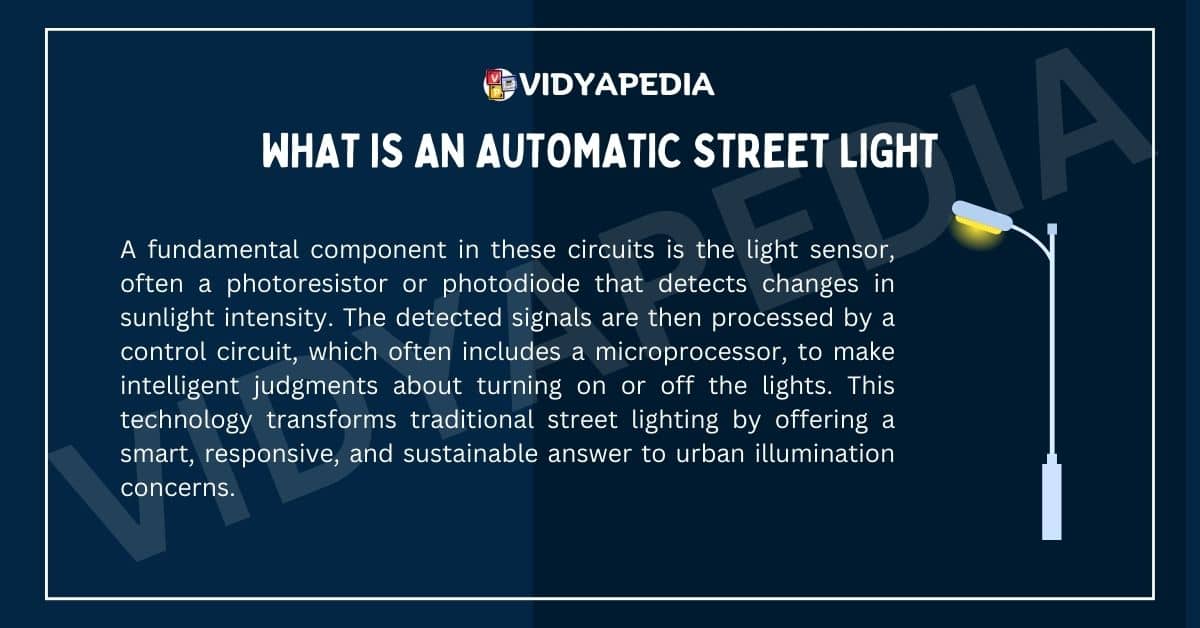
A fundamental component in these circuits is the light sensor, often a photoresistor or photodiode that detects changes in sunlight intensity. The detected signals are then processed by a control circuit, which often includes a microprocessor, to make intelligent judgments about turning on or off the lights. This technology transforms traditional street lighting by offering a smart, responsive, and sustainable answer to urban illumination concerns.
These circuits improve energy efficiency while also lowering electricity costs since they automatically adapt to real-time lighting needs. Beyond the financial gains, the environmental impact is decreased by eliminating wasteful energy consumption during daytime hours. Automatic street light and dark detector circuits are critical to modernising public lighting systems and represent a forward-thinking approach to urban infrastructure.
Have a look at the Light Detector Circuit too.
How To Make Automatic Street Light/Dark Detector Circuit
Circuit Diagram
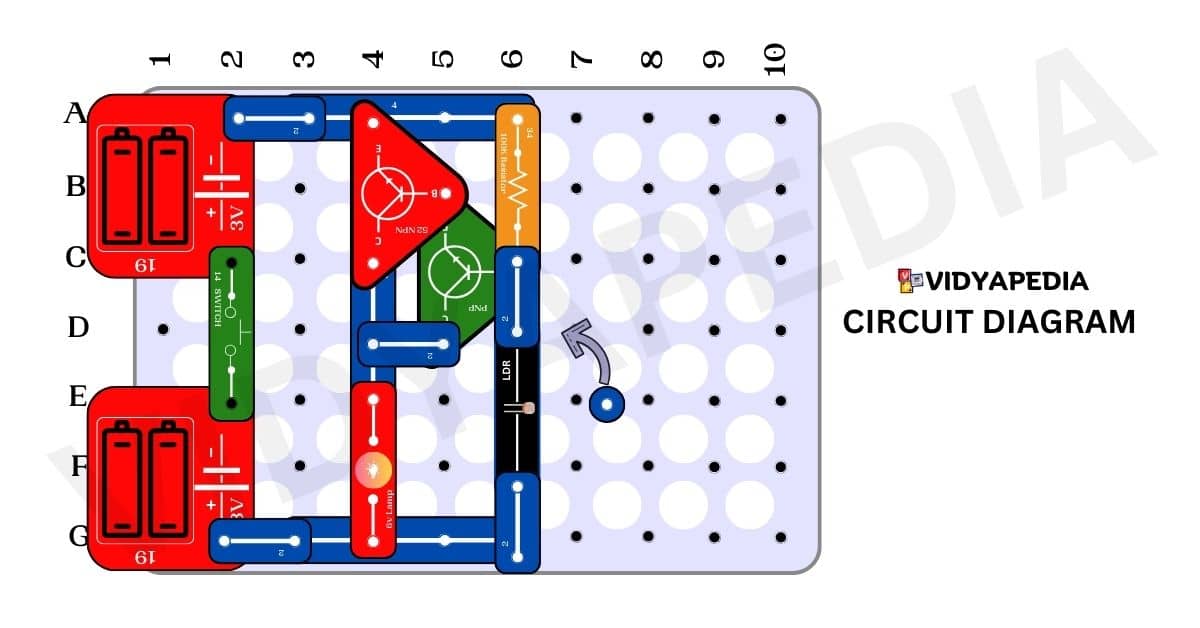
Components Required For Automatic Street Light
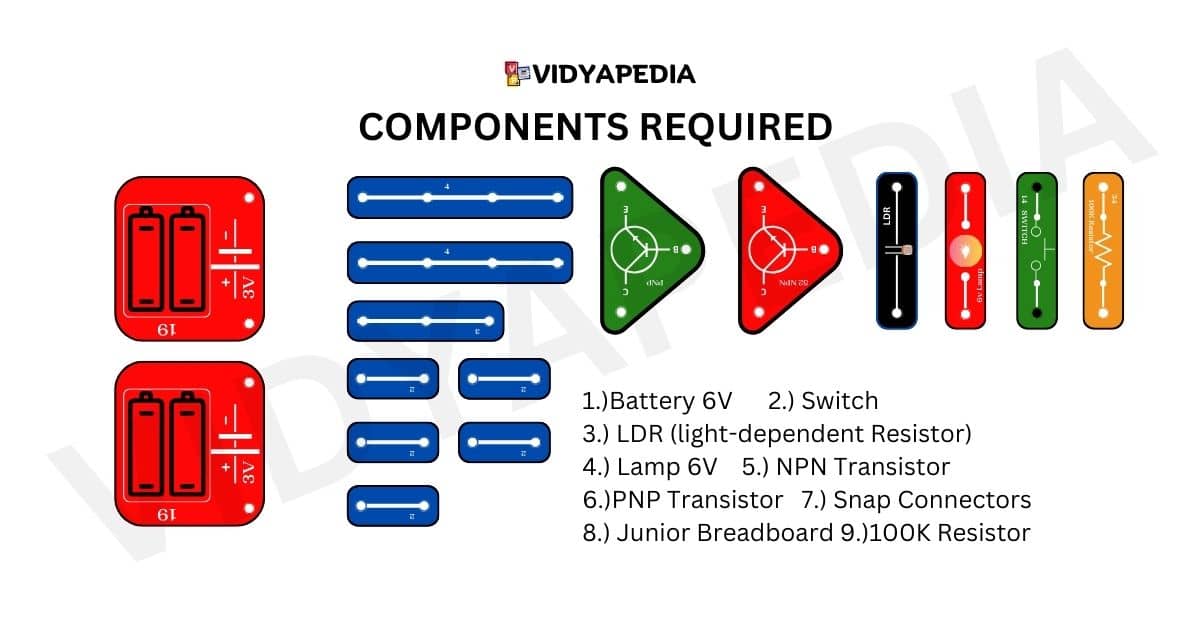
- Battery 6V
- Switch
- LDR (light-dependent Resistor)
- Lamp 6V
- NPN Transistor
- PNP Transistor
- Snap Connectors
- Junior Breadboard
- 100K resistor
Steps For Making an Automatic Street Light/Dark Detector Circuit
The first 8 steps of creating the automatic street light circuit are similar to the light detector circuit mentioned earlier, which you can refer to here for details. Now, continuing with the next steps:
- Connect a resistor to pins A6 and C6 on the breadboard.
- Connect the Light Dependent Resistor (LDR) to pins D6 and F6.
- Use a 2-pin snap connector to connect the LDR to pins D6 and C6.
- Connect a 2-pin snap connector to pins F6 and G6.
Working
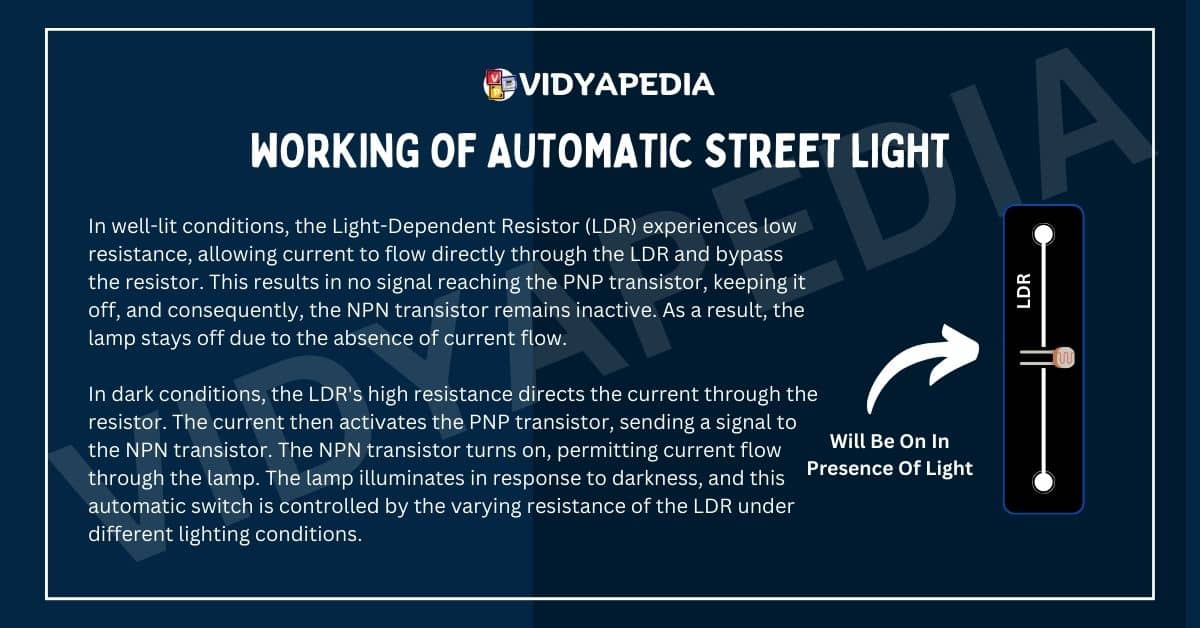
Working in light conditions:
- In well-lit conditions, the LDR experiences a decrease in resistance due to the abundance of light.
- The decreased resistance of the LDR allows current to flow through the circuit, creating a path with the lowest resistance.
- The current flows through the LDR, bypassing the resistor, and directly connects to the positive terminal of the battery.
- As a result, there is no signal sent to the base of the PNP transistor, keeping it in an off state.
- The NPN transistor also remains off since it doesn’t receive a signal from the PNP transistor.
- Consequently, there is no current flow through the lamp, and the lamp stays off in well-lit conditions.
Working in Dark Conditions:
- In low-light or dark conditions, the LDR exhibits an increase in resistance.
- The increased resistance prevents the current from flowing through the LDR easily.
- The current now takes the path through the resistor, as it offers lower resistance compared to the LDR in darkness.
- The current then flows to the base of the PNP transistor, turning it on.
- With the PNP transistor in an on state, it provides a path for the current to reach the base of the NPN transistor.
- The NPN transistor, receiving a signal, turns on, allowing current to flow through the lamp.
- The lamp illuminates as long as the ambient light is below the threshold set by the LDR, providing an automatic response to darkness.
Real-life applications of automatic street Street Light
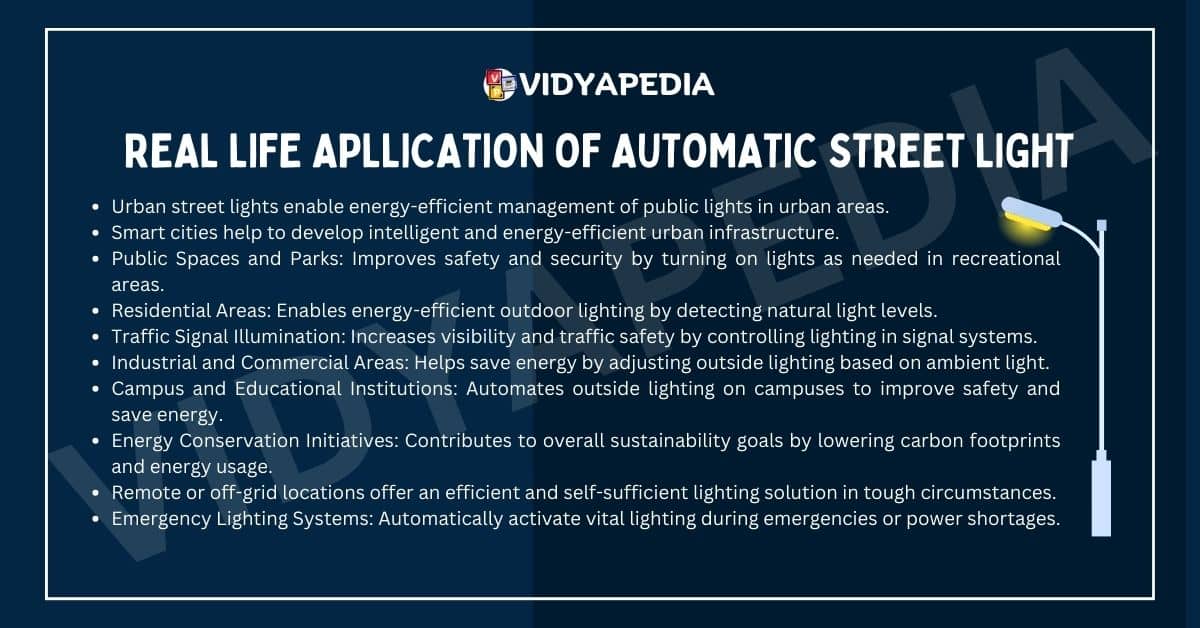
- Urban street lights enable energy-efficient management of public lights in urban areas.
- Smart cities help to develop intelligent and energy-efficient urban infrastructure.
- Public Spaces and Parks: Improves safety and security by turning on lights as needed in recreational areas.
- Residential Areas: Enables energy-efficient outdoor lighting by detecting natural light levels.
- Traffic Signal Illumination: Increases visibility and traffic safety by controlling lighting in signal systems.
- Industrial and Commercial Areas: Helps save energy by adjusting outside lighting based on ambient light.
- Campus and Educational Institutions: Automates outside lighting on campuses to improve safety and save energy.
- Energy Conservation Initiatives: Contributes to overall sustainability goals by lowering carbon footprints and energy usage.
- Remote or off-grid locations offer an efficient and self-sufficient lighting solution in tough circumstances.
- Emergency Lighting Systems: Automatically activate vital lighting during emergencies or power shortages.
Advantages of Automatic Street Lighting
- Energy Efficiency: Turns on street lights based on ambient light, reducing energy use.
- Cost Savings: Lowers electricity bills by regulating lighting during peak hours.
- Bulbs Last Longer: Reduces needless running hours, increasing bulb longevity.
- Integrated Light Sensors: Uses sensors to monitor in real-time and make responsive modifications.
- Microcontroller-based control uses microcontroller technology to provide precise control.
- Reduced Light Pollution: Reduces unwanted light dispersion, hence minimizing light pollution.
- Environmental Impact: Reduces carbon emissions by avoiding wasteful energy consumption.
- Smart Grid Integration: Works with smart grids to optimize energy coordination.
- Adaptive dimming adjusts brightness based on real-time activities to save energy.
- Remote Monitoring and Control: Enables remote modifications for more effective management.
Disadvantages of Automatic Street Lighting
- Dependency on Technology: Vulnerability to technical failures or malfunctions.
- Initial Installation Costs: There are higher upfront costs for sensor and control system implementation.
- Maintenance Complexity: Increased complexity requiring specialized skills for troubleshooting.
- Limited Suitability in Extreme Conditions: Performance challenges in harsh weather or environmental conditions.
- Security Concerns: Potential vulnerabilities in remote monitoring necessitate robust cybersecurity measures.
Frequently Asked Questions
How does the Automatic Street Light/Dark Detector Circuit save energy?
By activating street lights only when needed, the circuit, guided by the Light-Dependent Resistor (LDR), minimizes energy usage in well-lit conditions.
What are the crucial components of the circuit?
The LDR, NPN, and PNP transistors, resistors, and bulbs are all essential components. The LDR modulates transistor states, regulating automatic street light operation.
How does the circuit respond to varying light levels?
In terms of brightness, the LDR’s low resistance diverts current away from the light. In the dark, its high resistance reroutes current, triggering transistors and automatically turning on the lamp.
What maintenance advantages does the circuit provide?
The circuit’s simplicity decreases maintenance requirements. Routine checks guarantee LDR and connection integrity, reducing the likelihood of complex technical difficulties.
Can the circuit be adjusted to certain environments?
Yes, the circuit is flexible. By modifying LDR sensitivity or adding components, automatic street lights can be adjusted for varied situations and lighting preferences.

